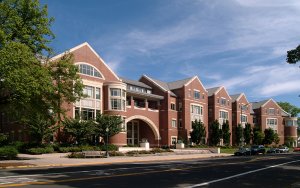The University of Oregon’s Knight Law Center makes changes to earn LEED certification
 EUGENE, Ore. – (June 17, 2014) – The University of Oregon’s William W. Knight Law Center has achieved LEED-EBOM Gold certification by the U.S. Green Building Council, the third UO building to achieve LEED Gold status, joining Matthew Knight Arena and the White Stag Block in Portland.
EUGENE, Ore. – (June 17, 2014) – The University of Oregon’s William W. Knight Law Center has achieved LEED-EBOM Gold certification by the U.S. Green Building Council, the third UO building to achieve LEED Gold status, joining Matthew Knight Arena and the White Stag Block in Portland.
Leadership in Energy and Environmental Design (LEED) status is awarded to buildings based on a point system denoting environmental friendliness. Knight Law Center earned certification as part of the LEED existing building program, which requires improved building operations be tracked during one year and submitted to LEED for review. Collaboration between campus operations and law school faculty and staff allowed building sustainability data to be recorded and ultimately approved.
“We have the extraordinary privilege of working in a building that is not only beautiful, but also thoughtfully designed and operated, in ways that are consistent with our school’s values,” said Dean Michael Moffitt. “I am proud of all who worked to help us reach the LEED Gold status.”
Changes made to the building to reach gold status include reduction of lighting through time delay and motion sensors, the use of eco-friendly cleaning agents and installing more energy efficient heating and cooling systems. Throughout the three-year period of changes, improvement in satisfaction of the law center was indicated by two comfort surveys sent to faculty, staff and students in the law school regarding lighting, noise level and general comfort.
“The changes and upgrades made to the Knight Law Center dramatically decrease the energy needed to operate our already outstanding facility,” said Oregon Law’s building manager Jim Horstrup. “These changes should serve not only the law school community but the University of Oregon on the whole.”
The 138,000-square-foot William W. Knight Law Center opened in fall of 1999 and was named for 1932 UO graduate and the father of Philip Knight, a founder of Nike and UO benefactor. This building replaced what is now known as McKenzie Hall as the home of the law school and law library.
Other high-performance buildings to join the university’s LEED team include the Ford Alumni Center, Lewis Integrative Science Building, Global Scholars Hall, Straub Hall and the Student Recreation Center Expansion. The Lillis Business Complex, which earned silver certification, was the first LEED building on campus.
About the U.S. Green Building Council (from usgbc.org)
The Washington, D.C.-based U.S. Green Building Council is committed to a prosperous and sustainable future for our nation through cost-efficient and energy-saving green buildings. With a community comprising 80 local affiliates, more than 18,000 member companies and organizations, and more than 167,000 LEED Professional Credential holders, USGBC is the driving force of an industry that is projected to contribute $554 billion to the U.S. gross domestic product from 2009-2013. USGBC leads an unlikely diverse constituency of builders and environmentalists, corporations and nonprofit organizations, elected officials and concerned citizens, and teachers and students. Buildings in the United States are responsible for 39 percent of CO2 emissions, 40 percent of energy consumption, 13 percent water consumption and 15 percent of GDP per year, making green building a source of significant economic and environmental opportunity. Greater building efficiency can meet 85 percent of future U.S. demand for energy, and a national commitment to green building has the potential to generate 2.5 million American jobs.
About LEED (from usgbc.org)
The U.S. Green Building Council's LEED green building certification system is the foremost program for the design, construction and operation of green buildings. More than 100,000 projects are currently participating in the LEED rating systems, comprising more than 8 billion square feet of construction space in all 50 states and 114 countries.
About Oregon Law
Since 1884, the University of Oregon School of Law has served the state, the nation and the world through a constantly renewed commitment to excellence in scholarship, classroom teaching and public service. Oregon Law is an American Bar Association accredited law school and the only public law school in the state of Oregon.
About the University of Oregon
The University of Oregon is among the 108 institutions chosen from 4,633 U.S. universities for top-tier designation of "Very High Research Activity" in the 2010 Carnegie Classification of Institutions of Higher Education. The UO also is one of two Pacific Northwest members of the Association of American Universities.
MEDIA CONTACT: Julie Brown, Public Affairs Communications, 541-346-3185, julbrown@uoregon.edu
SOURCE: Erick Hoffman, Oregon Law Communications, 541-346-1665, erickh@uoregon.edu
Note: The University of Oregon is equipped with an on-campus television studio with a point-of-origin Vyvx connection, which provides broadcast-quality video to networks worldwide via fiber optic network. In addition, there is video access to satellite uplink, and audio access to an ISDN codec for broadcast-quality radio interviews.
###